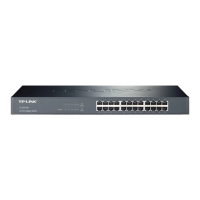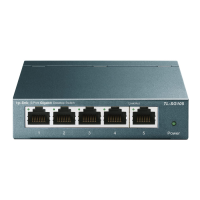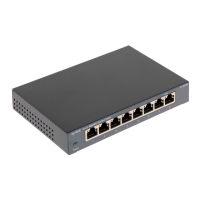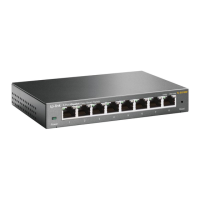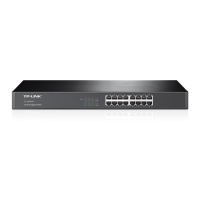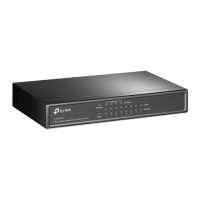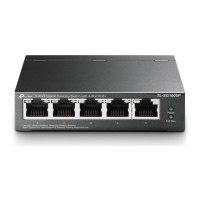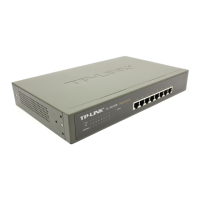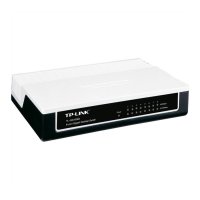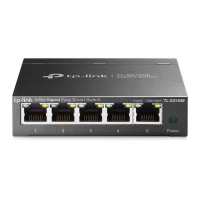Do you have a question about the TP-Link TL-SG1024DE and is the answer not in the manual?
Identifies the target users as network managers familiar with IT concepts and terminology.
Explains the symbols and formatting conventions used throughout the guide for better comprehension.
Provides links to TP-Link's support website for software updates, documentation, and community forums.
Introduces the Easy Smart Switch, detailing its models and key features like traffic monitoring, VLAN, QoS, and PoE.
Step-by-step instructions for accessing and logging into the switch's web interface for configuration purposes.
Overview of the System module for viewing and configuring switch parameters and overall features.
Procedures for viewing system information and specifying the device description for the switch.
Guides on setting the switch's IP address, either via DHCP or manual configuration.
Instructions for managing the administrator's username and password to enhance security and prevent unauthorized access.
Details on saving the current switch configuration and restoring it from a backup file.
Procedures for rebooting the switch for applying settings and resetting it to factory defaults.
Step-by-step guide on how to upgrade the switch's firmware for improved functionality and performance.
Lists the default settings for System Info, IP Address, and User Account configurations.
Introduces the switching capabilities, including port settings, IGMP Snooping, and LAG.
How to configure port status, speed, duplex mode, and flow control for network ports.
Guide on enabling IGMP Snooping for efficient multicast traffic handling and network load reduction.
Instructions for configuring LAG to combine multiple physical ports into a single logical link for increased bandwidth and reliability.
Practical examples demonstrating the configuration of IGMP Snooping and LAG for common network scenarios.
Lists the default settings for Port, IGMP Snooping, and LAG configurations.
Overview of the switch's monitoring capabilities for observing network traffic and status.
Detailed steps to view port statistics, including traffic counts, errors, and link status.
How to set up port mirroring to capture and analyze network traffic for troubleshooting purposes.
Guide on performing cable tests to diagnose connection issues and identify fault locations.
Steps to enable loop prevention to automatically detect and block network loops, preventing disruption.
Lists the default settings for Port Mirror and Loop Prevention configurations.
Explains VLANs, their benefits in network segmentation, and the supported modes: MTU, Port Based, and 802.1Q.
Steps to configure MTU VLAN, which involves defining an uplink port to create multiple isolated VLANs.
Guide on setting up port-based VLANs, assigning specific ports to different VLAN IDs for network segmentation.
Detailed instructions for implementing 802.1Q VLANs, including creating VLANs and managing tagged/untagged ports.
A practical example illustrating 802.1Q VLAN configuration with network requirements, topology, and step-by-step instructions.
Lists the default configurations for MTU VLAN, Port Based VLAN, 802.1Q VLAN, and PVID settings.
Explains Quality of Service (QoS) and its importance in managing network traffic for better performance and user experience.
Details the three QoS modes: Port Based, 802.1P Based, and DSCP/802.1P Based for traffic prioritization.
Guides on configuring ingress and egress bandwidth limits per port to optimize network resource allocation.
Steps to configure storm control to prevent network instability caused by excessive traffic types like broadcast or multicast.
A practical example demonstrating how to configure QoS in port-based mode to prioritize specific traffic during network congestion.
Lists the default settings for QoS Basic, Bandwidth Control, and Storm Control configurations.
Introduces Power over Ethernet (PoE) technology, explaining its function in powering devices via Ethernet cables.
Details the process of configuring PoE settings, including system power limits and individual port power management.
Identifies the target users as network managers familiar with IT concepts and terminology.
Explains the symbols and formatting conventions used throughout the guide for better comprehension.
Provides links to TP-Link's support website for software updates, documentation, and community forums.
Introduces the Easy Smart Switch, detailing its models and key features like traffic monitoring, VLAN, QoS, and PoE.
Step-by-step instructions for accessing and logging into the switch's web interface for configuration purposes.
Overview of the System module for viewing and configuring switch parameters and overall features.
Procedures for viewing system information and specifying the device description for the switch.
Guides on setting the switch's IP address, either via DHCP or manual configuration.
Instructions for managing the administrator's username and password to enhance security and prevent unauthorized access.
Details on saving the current switch configuration and restoring it from a backup file.
Procedures for rebooting the switch for applying settings and resetting it to factory defaults.
Step-by-step guide on how to upgrade the switch's firmware for improved functionality and performance.
Lists the default settings for System Info, IP Address, and User Account configurations.
Introduces the switching capabilities, including port settings, IGMP Snooping, and LAG.
How to configure port status, speed, duplex mode, and flow control for network ports.
Guide on enabling IGMP Snooping for efficient multicast traffic handling and network load reduction.
Instructions for configuring LAG to combine multiple physical ports into a single logical link for increased bandwidth and reliability.
Practical examples demonstrating the configuration of IGMP Snooping and LAG for common network scenarios.
Lists the default settings for Port, IGMP Snooping, and LAG configurations.
Overview of the switch's monitoring capabilities for observing network traffic and status.
Detailed steps to view port statistics, including traffic counts, errors, and link status.
How to set up port mirroring to capture and analyze network traffic for troubleshooting purposes.
Guide on performing cable tests to diagnose connection issues and identify fault locations.
Steps to enable loop prevention to automatically detect and block network loops, preventing disruption.
Lists the default settings for Port Mirror and Loop Prevention configurations.
Explains VLANs, their benefits in network segmentation, and the supported modes: MTU, Port Based, and 802.1Q.
Steps to configure MTU VLAN, which involves defining an uplink port to create multiple isolated VLANs.
Guide on setting up port-based VLANs, assigning specific ports to different VLAN IDs for network segmentation.
Detailed instructions for implementing 802.1Q VLANs, including creating VLANs and managing tagged/untagged ports.
A practical example illustrating 802.1Q VLAN configuration with network requirements, topology, and step-by-step instructions.
Lists the default configurations for MTU VLAN, Port Based VLAN, 802.1Q VLAN, and PVID settings.
Explains Quality of Service (QoS) and its importance in managing network traffic for better performance and user experience.
Details the three QoS modes: Port Based, 802.1P Based, and DSCP/802.1P Based for traffic prioritization.
Guides on configuring ingress and egress bandwidth limits per port to optimize network resource allocation.
Steps to configure storm control to prevent network instability caused by excessive traffic types like broadcast or multicast.
A practical example demonstrating how to configure QoS in port-based mode to prioritize specific traffic during network congestion.
Lists the default settings for QoS Basic, Bandwidth Control, and Storm Control configurations.
Introduces Power over Ethernet (PoE) technology, explaining its function in powering devices via Ethernet cables.
Details the process of configuring PoE settings, including system power limits and individual port power management.
| Switch type | Managed |
|---|---|
| Switch layer | L2 |
| Quality of Service (QoS) support | Yes |
| Installed SFP modules quantity | 0 |
| Basic switching RJ-45 Ethernet ports type | Gigabit Ethernet (10/100/1000) |
| Basic switching RJ-45 Ethernet ports quantity | 24 |
| 10G support | No |
| Number of VLANs | 32 |
| Networking standards | IEEE 802.1Q, IEEE 802.1p, IEEE 802.3, IEEE 802.3ab, IEEE 802.3u, IEEE 802.3x |
| Virtual LAN features | Port-based VLAN, Tagged VLAN |
| Cable types supported | Cat3, Cat5, Cat6 |
| Copper ethernet cabling technology | 10BASE-T, 100BASE-TX, 1000BASE-T |
| Jumbo frames | 9216 |
| Forwarding rate | 35.7 Mpps |
| Number of queues | 4 |
| MAC address table | 8000 entries |
| Packet buffer memory | 0.512 MB |
| Power source | AC |
| AC input voltage | 100 - 240 V |
| AC input frequency | 50 - 60 Hz |
| Power consumption (max) | 14.86 W |
| Stackable | - |
| Form factor | 1U |
| Certification | FCC, CE, RoHS |
| Product color | Black |
| Heat dissipation | 114.37 BTU/h |
| Storage temperature (T-T) | -40 - 70 °C |
| Operating temperature (T-T) | 0 - 40 °C |
| Storage relative humidity (H-H) | 5 - 90 % |
| Operating relative humidity (H-H) | 10 - 90 % |
| Compatible operating systems | Windows 98SE, NT, 2000, XP, Vista, Windows 7, Windows 8, MAC OS, NetWare, UNIX, Linux |
| Package type | Box |
| Package depth | 400 mm |
| Package width | 250 mm |
| Package height | 80 mm |
| Package weight | 2020 g |
| Harmonized System (HS) code | 85176990 |
| Depth | 180 mm |
|---|---|
| Width | 294 mm |
| Height | 44 mm |


